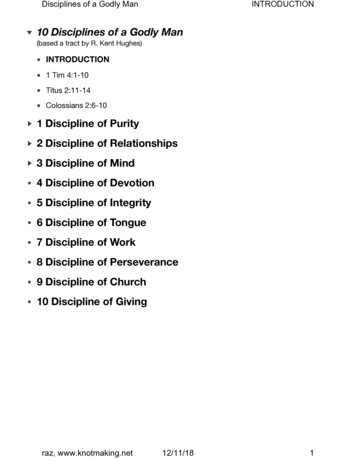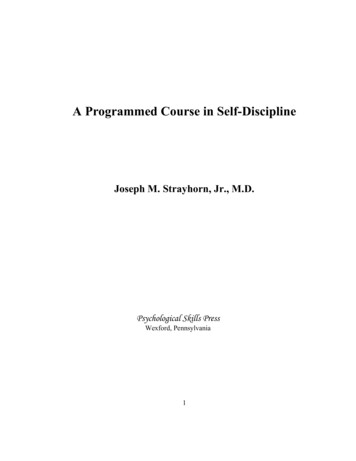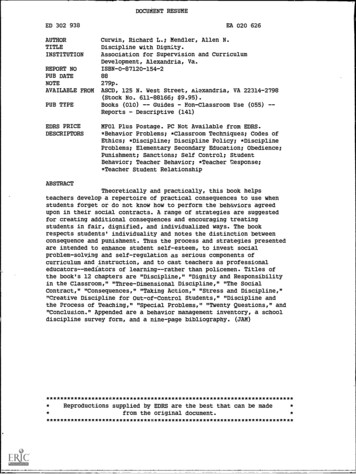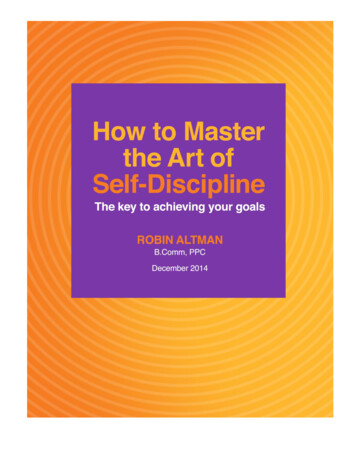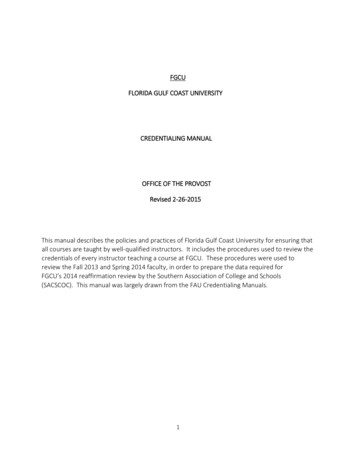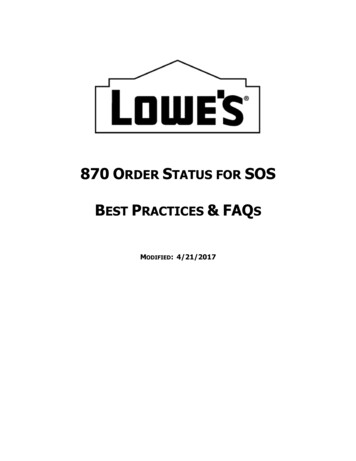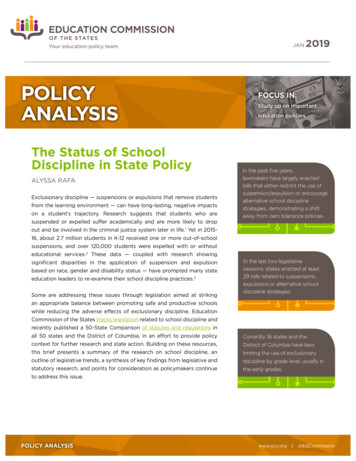
Transcription
JANPOLICYANALYSISThe Status of SchoolDiscipline in State PolicyALYSSA RAFAExclusionary discipline — suspensions or expulsions that remove studentsfrom the learning environment — can have long-lasting, negative impactson a student’s trajectory. Research suggests that students who aresuspended or expelled suffer academically and are more likely to drop2019FOCUS IN.Study up on importanteducation policies.In the past five years,lawmakers have largely enactedbills that either restrict the use ofsuspension/expulsion or encouragealternative school disciplinestrategies, demonstrating a shiftaway from zero tolerance policies.out and be involved in the criminal justice system later in life.1 Yet in 201516, about 2.7 million students in K-12 received one or more out-of-schoolsuspensions, and over 120,000 students were expelled with or withouteducational services.2 These data — coupled with research showingsignificant disparities in the application of suspension and expulsionbased on race, gender and disability status — have prompted many stateeducation leaders to re-examine their school discipline practices.3Some are addressing these issues through legislation aimed at strikingIn the last two legislativesessions, states enacted at least29 bills related to suspensions,expulsions or alternative schooldiscipline strategies.an appropriate balance between promoting safe and productive schoolswhile reducing the adverse effects of exclusionary discipline. EducationCommission of the States tracks legislation related to school discipline andrecently published a 50-State Comparison of statutes and regulations inall 50 states and the District of Columbia, in an effort to provide policyCurrently, 16 states and thecontext for further research and state action. Building on these resources,District of Columbia have lawsthis brief presents a summary of the research on school discipline, anlimiting the use of exclusionaryoutline of legislative trends, a synthesis of key findings from legislative anddiscipline by grade level, usually instatutory research, and points for consideration as policymakers continuethe early grades.to address this issue.POLICY ANALYSISwww.ecs.org @EdCommission
2What Does the Research Say?Wide-Ranging, Long-Term Negative ImpactsResearch suggests that students who experience exclusionary discipline — such as suspension or expulsion — aremore likely to experience a variety of negative outcomes, including decreased academic performance, increasedrates of grade retention and drop out, increased likelihood of future involvement with the criminal justice system anddecreased likelihood of economic success as adults.4While exclusionary discipline has a direct, negative impact on the student, effects are felt beyond the individual andcommunity levels. Research suggests that high suspension and expulsion rates also have significant long-term impactson state economies.5 State-specific studies document net economic losses because of delayed workforce entry causedin part by school suspensions and expulsions.6Disparities in Suspension and ExpulsionResearch indicates that the negative effects of exclusionary discipline are morepronounced for males, students of color and students with disabilities — groupsthat have historically experienced higher rates of suspension and expulsion. ForThe school-to-prison pipelineexample, national data from the 2013-14 school year show that black studentsrefers to the process by whichin K-12 schools were 3.8 times as likely to be suspended, and twice as likely tobe expelled, as white students.7 Similarly, students with disabilities were morestudents are funneled out ofthan twice as likely to receive out-of-school suspensions as students withoutthe school system and into thedisabilities.8 These disparities persisted regardless of type of disciplinaryaction, level of school poverty or type of public school attended, accordingjuvenile and criminal justiceto a 2018 report from the Government Accountability Office.9systems. Contributing factorsExperts suggest that a child’s early educational experiences greatly influenceto this phenomenon maytheir development and outcomes later in life, yet preschool students generallyinclude: exclusionary disciplineare expelled at three times the rate of children in K-12 — signaling a trendof removing young learners from the classroom.10 In addition, disparities bygender and race are evident: Black preschoolers are 3.6 times as likely toreceive an out-of-school suspension as their white classmates, and boys arealmost four times as likely as girls to be suspended in preschool.11Suspensions and expulsions are considered a key touchpoint along thepolicies (including suspension,expulsion and school-relatedarrests); disparate applicationof those policies; increasedschool-to-prison pipeline because students who experience exclusionaryrates of disengagement anddiscipline are far more likely to have continued contact with the criminaldrop-out; and increased policejustice system later in life. Data on the prevalence and disparate applicationof school-related arrests provide further insight: Black students are aboutpresence in schools.13two times as likely as white students to receive a referral to law enforcementor be subject to a school-related arrest.12POLICY ANALYSISwww.ecs.org @EdCommission
3Alternatives to Exclusionary DisciplineAlternative school discipline strategies aim to address the root causes of misbehavior by building strong and healthyrelationships with students and improving their engagement with the learning environment. Strategies that arecurrently popular in states include schoolwide positive behavioral interventions and supports (SW-PBIS), restorativepractices and trauma-informed practices.KEY TERMSSchoolwide Positive Behavioral Interventions and Supports: SW-PBIS is a framework forthe selection and use of evidence-based practices to support students in their academic,social, emotional and behavioral competencies. This system of support aims to improvestudent behavior and school climate and includes proactive strategies for defining,teaching and supporting appropriate student behaviors at the school, classroom andindividual levels.Restorative Practices: Borrowed from the criminal justice concept of restorative justice,restorative practices aim to institutionalize peaceful and nonpunitive approaches toaddressing the root causes of student misbehavior. Restorative approaches shift theemphasis from managing behavior to focusing on building, nurturing and repairingrelationships. In practice, this could include mediated dialogue, conferencing betweengroups of students, and forming positive and responsive circles.Trauma-Informed Practices: Research indicates that childhood trauma can make itchallenging for students to learn and focus in school.14 Trauma-informed practices createschool environments that understand and consider adverse childhood experiences whenmaking decisions about school discipline.While research on the use of alternative strategies is still relatively new, some studies suggest that certain, wellimplemented programs have the potential to achieve multiple, positive outcomes for students. For instance, specificresearch on SW-PBIS provides evidence that these programs may increase academic engagement, improve overallstudent behavior and decrease the number of students excluded from the learning environment for disciplinaryreasons.15 Early research findings indicate that effective alternative programs have some common elements, includingadequate funding, ample implementation timelines, fidelity to the chosen model, dedicated staff members, andsupport and training for all engaged staff.16CASE STUDY ON RESTORATIVE PRACTICESDenver Public Schools, Colorado’s largest school district, has implemented and evaluated restorative practicesat several school sites since 2003. One longitudinal study of the impact of restorative practices in DPS foundthat over the period of implementation, suspension rates decreased, racial disparities were reduced, and testscores were improved for all student groups in nearly every subject, every year.17POLICY ANALYSISwww.ecs.org @EdCommission
4Past State Policy TrendsIn the late 1990s and early 2000s, there was a wave of school discipline legislation — commonly referred to as zerotolerance policies — aimed at expanding the list of violations for which suspension and expulsion could be used andrequiring harsh consequences for certain violations (often those including drugs or weapons). Studies showed thatthese policies increased suspension and expulsion rates across the country, especially among students of color andstudents with disabilities — thereby disproportionately removing these students from the learning environment.18Zero Tolerance and Reform Bills Enacted in 2000-18ReformZero ToleranceThis graph depicts trend lines (foreground) as well as raw data (background) on the number of bills passed in both the zerotolerance and reform categories.In recent years, zero-tolerance legislation has stalled: About seven bills expanding suspension or expulsion have beenenacted in state legislatures in the last five years.19 In that same time frame, state legislatures have enacted at least 36bills restricting the use of suspension or expulsion or encouraging the use of alternative school discipline strategies —demonstrating a movement away from zero tolerance and toward less-punitive strategies.20 Generally, these bills placelimitations on the length of suspension or expulsion, disallow the use of suspension or expulsion in the early grades,require consideration of student circumstances and context and/or encourage the use of alternative strategies. 21Legislation in 2017 and 2018 has generally followed the trends of the last five years: placing limitations on punitivediscipline, encouraging the use of alternative strategies and implementing planning and reporting requirements. Inthe 2017 legislative session, lawmakers proposed at least 35 bills related to suspension and expulsion and 26 billsrelated to alternative school discipline strategies. Of those, 14 were enacted. In 2018, at least 11 states and the Districtof Columbia enacted 15 bills broadly related to suspension, expulsion or alternatives to discipline.POLICY ANALYSISwww.ecs.org @EdCommission
5Enacted Legislation: Suspension, Expulsion or Alternatives to Enacted 2018AKEnacted 2017Enacted Both YearsHIEXAMPLES OF ENACTED STATE LEGISLATION IN 2018Delaware: S.B. 85-1 requires the state department of education to compile and release an annual school disciplinereport that includes statewide and individual school totals for out-of-school suspensions, expulsions, alternativeschool assignments and in-school suspensions — all disaggregated by race, ethnicity, gender, disabilitystatus, grade level, limited English proficiency, incident type and discipline duration. Schools meeting certainthresholds of suspension or expulsion for three consecutive years must review their discipline policies, assure properimplementation of restorative justice practices and submit a corrective plan to the state department of education.Georgia: H.B. 740 requires local school systems to implement certain, multi-tiered systems of supports andreviews prior to expelling or suspending a student in pre-kindergarten through third grade for five or more daysduring the school year. This bill outlines exceptions for weapon possession, drug offenses or endangering others.Indiana: H.B. 1421 requires the state department of education to conduct a survey of school discipline policies todetermine the extent to which positive discipline and restorative justice practices are currently used. Additionally,this bill requires the state’s model plan for improving student behavior and discipline must reduce out-of-schoolsuspensions and disproportionality in all discipline and exclusion, limit referrals to law enforcement or school-relatedarrests and include policies that address bullying on school property. The state department of education mustprovide information and assistance to districts regarding the implementation of this plan, ensuring that teachers andadministrators receive appropriate support and professional development.Michigan: H.B. 5531 is an exception to the trend of states limiting suspension or expulsion. This bill expands thelist of violations for which students must be expelled to include criminal sexual conduct against another pupilenrolled in the same school district.POLICY ANALYSISwww.ecs.org @EdCommission
6Current State PoliciesIn 2018, Education Commission of the States examined current statutes in all 50 states and the District of Columbia tocreate a 50-State Comparison of current school discipline laws. This provided in-depth information for each state onthe types of violations for which students may be suspended or expelled, the limitations on and reporting requirementsfor those suspensions and expulsions and any alternative school discipline strategies cited in statute.JJViolation Types. State statutes vary widely on the types of violations for which they require or allow studentsto be suspended or expelled. All 50 states and the District of Columbia require students to be expelled for possession of a firearm oncampus, in compliance with the federal Gun Free Schools Act. At least 40 states allow students to be suspended for defiant or disruptive behavior. At least 36 states and the District of Columbia either require or allow students to be suspended for assaultor physical harm. At least 26 states and the District of Columbia either require or allow students to be suspended or expelledas a punishment for drug use or possession. At least 12 states and the District of Columbia provide suspension or expulsion as an option in incidents of bullying.HOW MANY STATES ADDRESS THESE VIOLATIONS IN STATUTE?22151114216381124*Note: Overall state counts include the District of Columbia.JJLimitations on Suspension and Expulsion. The 50-State Comparison shows that most states place somelimitation on the use of suspension or expulsion in statute. At least 16 states and the District of Columbia limit use by grade level, usually in the early grades. Several states also limit the use of exclusionary discipline for certain violations. At least 17 states and theDistrict of Columbia prohibit suspension or expulsion solely for a student’s attendance or truancy issues.JJReporting Requirements. At least 33 states and the District of Columbia require some level of reporting onschool discipline; about 11 states and the District of Columbia explicitly require suspension and expulsion data tobe disaggregated by demographic categories, such as race, gender and disability status.JJAlternative School Discipline Strategies. At least 30 states and the District of Columbia encourage districts andschools to use alternative school discipline strategies; 22 of those states mention specific interventions.POLICY ANALYSISwww.ecs.org @EdCommission
7Types of School Discipline StatutesAdditionally, multiple states are using opportunities provided under the Every Student Succeeds Act to incorporateschool discipline data into their systems for accountability and school improvement. Those opportunities include:JJReporting Requirements. ESSA requires all states to collect data on rates of in-school and out-of-schoolsuspensions and include that information on state report cards.JJSchool Quality and Student Success Indicator. In addition to measures of academic achievement, graduationrates, and English language proficiency, statewide accountability systems must include at least one measure ofSQSS. ESSA gives states some flexibility in choosing which measure to include, which leaves room to includeschool discipline data.JJInforming School Improvement. ESSA requires that states have a plan in place for intervening in schools identifiedthrough their accountability system as in need of improvement. Even if states choose not to use discipline datato identify schools for improvement, they still have the option to use discipline data to inform the improvementprocess for struggling schools.Education Commission of the States’ recent 50-State Comparison of state ESSA plans shows that multiple statesare using these opportunities to incorporate school discipline data into their accountability systems. Three states —California, Rhode Island and West Virginia — are planning to use suspension rates directly within their SQSS measure:JJCalifornia plans to include the percentage of students suspended in K-12 (in-school and out-of-school suspensions)each year, as well as the annual change in suspension rates.JJRhode Island plans to include the rate of out-of-school suspensions in pre-K through 12th grade, as well asmeasures of chronic absenteeism.JJWest Virginia plans to include the percentage of students who received zero out-of-school suspensions duringthe school year in elementary and middle school, as well as overall school attendance rates.POLICY ANALYSISwww.ecs.org @EdCommission
8An additional six states — Alabama, Arizona, Arkansas, Kansas, Minnesota and Washington — are opting to usediscipline data to inform various aspects of the school improvement process:22JJPlanning and Needs Assessment: Washington requires that district improvement plans include an analysis ofsuspension and expulsion rates to identify interventions and alternative discipline strategies. Similarly, Arkansasand Minnesota require schools in need of improvement to review and analyze disciplinary data as part of theirneeds assessment process.JJInterventions: Arizona plans to provide technical assistance on several topics — including alternatives tosuspension, restorative justice and conscious discipline — to districts with a significant number of schools inneed of improvement. Alabama also includes the assessment and refinement of disciplinary practices in a list ofinterventions targeted at schools in need of improvement.JJExiting Identification: Kansas requires that schools in need of improvement decrease their suspension andexpulsion rates in order to exit identification status.Policy ConsiderationsWhile this brief is focused primarily on state-level policy, it is important to note that in many states, the details ofschool discipline policies are created and applied at the district or school level. As a result, local implementationmay vary based on individual contexts. State policy can, however, enable conditions for effective implementation byproviding support and ensuring accountability. The following are examples of policy levers available to state leaders.JJTechnical Assistance. State support for local implementation may include the development and distribution ofmodel school discipline policies, professional development strategies and implementation manuals.JJData Collection and Reporting. Collecting, using and reporting disaggregated discipline data allows educatorsand state leaders to assess whether interventions have been effective at the local and state levels. State leaderscan use policy incentives and requirements to ensure data are collected and reported consistently, empoweringeducators to apply timely interventions with their discipline data.JJFinancial Support. Policymakers can create funding initiatives to support local implementation of moresupportive school discipline practices. This can be in the form of pilot programs, grants or statewidecompetitive funding initiatives, among other models; and may be targeted to support staff training,infrastructure, technology or other emergent needs.JJImplementation Considerations. State policymakers continue to encourage the use of alternative schooldiscipline strategies. In doing so, they may consider outlining common elements of effective programs,including funding, fidelity to the model chosen, staff support and training and adequate implementationtimelines. Additionally, leaders may assist schools and districts as they work to choose which strategies bestapply to their contexts.JJSchool Improvement Requirements. ESSA provides flexibility to state leaders as they work with schools anddistricts to develop effective frameworks for school improvement. As policymakers develop models, incentivesand accountability structures around school improvement, they have the opportunity to build in requirementsfor reporting on local policy and practice around school discipline.POLICY ANALYSISwww.ecs.org @EdCommission
9ENDNOTES1.Tony Fabelo et al., Breaking Schools’ Rules: A StatewideStudy of How School Discipline Relates to Students’Success and Juvenile Justice Involvement (New York:Council of State Governments Justice Center, July ads/2012/08/Breaking Schools Rules Report Final.pdf.2.2015-2016 Civil Rights Data Collection: School Climate andSafety (Washington: U.S. Department of Education, Office forCivil Rights, April 2018), hool-climate-and-safety.pdf.3.Alyssa Rafa, Policy Snapshot: Suspension and Expulsion(Denver: Education Commission of the States, January /.4.Amity L. Noltemeyer, Rose Marie Ward, and Caven Mcloughlin,“Relationship Between School Suspension and StudentOutcomes: A Meta-Analysis,” School Psychology Review 44,no. 2, (June 2015): 224-240, 4-0008.1?code naps-site; and Fabeloet al., “Breaking Schools’ Rules; Miner P. Marchbanks III et al.,The Economic Effects of Exclusionary Discipline on GradeRetention and High School Dropout” (paper presented at theClosing the School Discipline Gap conference, Washington, DC,January 2013) school-dropout.5.Ibid.6.Ibid.7.2013-2014 Civil Rights Data Collection: A First Look(Washington: U.S. Department of Education, Office for CivilRights, October 2016), 13-14-first-look.pdf.8.Ibid.9.Jacqueline M. Nowicki, K-12 Education: Discipline Disparitiesfor Black Students, Boys, and Students with Disabilities(Washington: United States Government Accountability Office,March 2018), https://www.gao.gov/assets/700/690828.pdf.POLICY ANALYSIS10.Walter S. Gilliam, Prekindergarteners Left Behind: ExpulsionRates in State Prekindergarten Systems (New Haven: YaleUniversity Child Study Center, May 2005), leteReport.pdf.11.2013-2014 Civil Rights Data Collection; and Civil RightsData Collection: Data Snapshot—Early Childhood Education(Washington: U.S. Department of Education Office for CivilRights, March 2014), dc-early-learning-snapshot.pdf.12.2013-2014 Civil Rights Data Collection.13.Russell J. Skiba, Mariella I. Arredondo, and Natasha T. Williams,“More Than a Metaphor: The Contribution of ExclusionaryDiscipline to a School-to-Prison Pipeline,” Equity & Excellencein Education 47, no.4 (November 2014): 546-564, 84.2014.958965.14.Manuel E. Jimenez et al., “Adverse Experiences in EarlyChildhood and Kindergarten Outcomes,” Pediatrics 137, no.2 (February 2016), .Terrance M. Scott, Joseph Calvin Gagnon, and C. MichaelNelson, “School-wide systems of positive behavior support:A framework for reducing school crime and violence,”The Journal of Behavior Analysis of Offender and VictimTreatment and Prevention 1, no. 3 (2008): 259-272, http://psycnet.apa.org/record/2014-55090-004; and Catherine P.Bradshaw, Tracy E. Waasdorp, and Philip J. Leaf, “Effects ofSchool-Wide Positive Behavioral Interventions and Supportson Child Behavior Problems,” Pediatrics 130, no. 5 (November2012): 1136-1145, 90.16.Al Passarella, Restorative Practices in Schools (Baltimore:Johns Hopkins Institute for Education Policy, May 2017), pdf.17.Thalia González, “Socializing Schools: Addressing RacialDisparities in Discipline Through Restorative Justice,” in Closingthe School Discipline Gap: Equitable Remedies for ExcessiveExclusion, ed. Daniel J. Losen (New York: Teachers’ CollegePress, 2015).www.ecs.org @EdCommission
1018.19.F. Chris Curran, “Estimating the Effect of State Zero ToleranceLaws on Exclusionary Discipline, Racial Discipline Gaps, andStudent Behavior,” Educational Evaluation and Policy Analysis38, no. 4 (August 2015): 647-668, 6652728.See Education Commission of the States’ State EducationPolicy Tracking resource (2017-present): g/ (1996-2016): . Ibid.21.Rafa, Policy Snapshot.22. Stephen Kostyo, Jessica Cardichon, and Linda DarlingHammond, Making ESSA’s Equity Promise Real: StateStrategies to Close the Opportunity Gap (Palo Alto: LearningPolicy Institute, October 2018), files/product-files/ESSA Equity PromiseSuspension BRIEF.pdf.AUTHORAlyssa Rafa is a policy analyst at Education Commission of the States. She holds a master’s degree from the Universityof Denver. In her free time, Alyssa enjoys hiking, skyping with her family and doing home improvement projects.Contact Alyssa at arafa@ecs.org or 303.299.3691. 2019 by Education Commission of the States. All rights reserved. Education Commission of the States encourages its readers to share ourinformation with others. To request permission to reprint or excerpt our material, please contact us at 303.299.3609 or email askinner@ecs.org.Education Commission of the States 700 Broadway Suite 810 Denver, CO 80203POLICY ANALYSISwww.ecs.org @EdCommission
Zero Tolerance and Reform Bills Enacted in 2000-18 This graph depicts trend lines (foreground) as well as raw data (background) on the number of bills passed in both the zero tolerance and reform categories. In recent years, zero-tolerance legislation has stalled: About seven bills expanding suspension or expulsion have been

